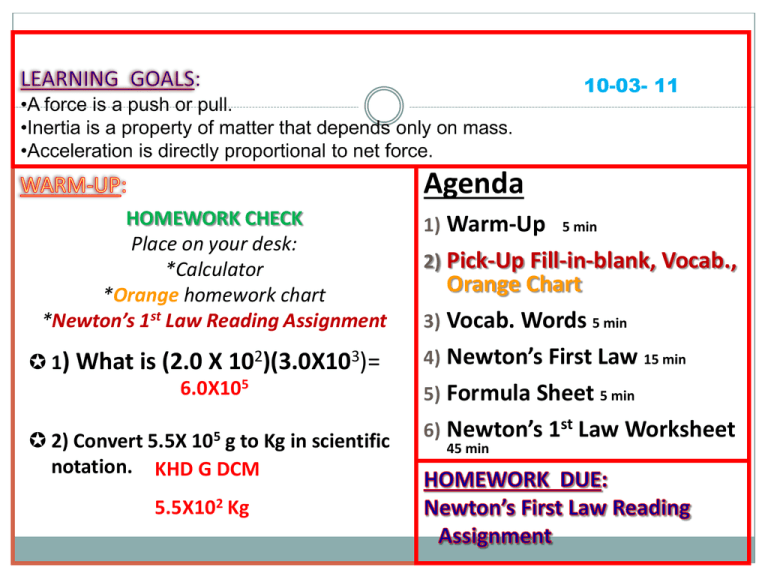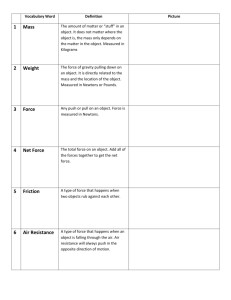2.1 Newtons 1st Law
advertisement

10-03- 11 Agenda HOMEWORK CHECK Place on your desk: *Calculator *Orange homework chart *Newton’s 1st Law Reading Assignment 1) What is (2.0 X 102)(3.0X103)= 6.0X105 2) Convert 5.5X 105 g to Kg in scientific notation. KHD G DCM 5.5X102 Kg 1) Warm-Up 5 min 2) Pick-Up Fill-in-blank, Vocab., Orange Chart 3) Vocab. Words 5 min 4) Newton’s First Law 15 min 5) Formula Sheet 5 min 6) Newton’s 1st Law Worksheet 45 min Vocab. 1. Force: any push or pull; measured in Newton’s (N); can be any of the main basic types: friction, weight, tension, stretch, normal force, etc. 2. Friction: force that acts between materials that touch as they move past each other; acts parallel to the surface in contact & opposite the motion 3. Inertia: resisting change in its state of motion; property of all bodies of matter. 4. Kilogram: SI unit of mass • Forces affect motion. A force is a physics quantity that can affect the state of motion of an object. • A force is any push or pull. Since forces have magnitude & direction, and can be combined with other forces, it is a vector quantity. • The study of forces which cause motion is called dynamics and the relationship of force, mass and motion are described by Newton’s Law of Motion. A. Characteristics of forces 1. Net forces will change the state of motion of an object (application of a net force to an object always produces acceleration) 2. Can be exerted through long distances 3. Occurs in pairs 4. Each pair, each force works opposite of the other—can be balanced or unbalanced. Types of forces Net force, normal force (acts at right angles), equilibrant force, friction, weight, fluid forces, air resistance, pressure etc. -Unit of measurement for all forces is the Newton (N) which is equal to the mass of the object times the amount of gravity acting on the mass: 1 N=1Kg (9.8 m/s2)=N 1 N=9.8 Kg m/s2 ***F=mg -Instrument used to measure forces is spring scale. -Instrument measures the amount of stretch which is proportional to the force pulling on the spring or equal to the amount of force acting on the spring as long as its restoring strength is intact (Hooke’s Law) -Friction Force of friction depends on the kinds of materials in contact & how many surfaces are pressed together; fluid friction is found in fluids (liquids & gases); air resistance which is friction due to movement in the air—noticed at high speeds. Friction tends to balance the applied force & give a net foce of zero (0) -Pressure Pressure is the amount of force per unit area & is measured in Pa (pascals) -Free Fall—force of gravity If friction is neglected, objects of different mass will fall at the same rate of acceleration due to the same amount of gravity acting on the objects. -1st law of Motion: Law of Inertia Law deals with the motion on which NO net force is acting. Law says “If there is no net force acting on a body, it will continue in its state of rest or will continue moving along a straight line with constant speed.” (Things tend to keep on doing what they are already doing or in the absence of forces, a moving object tends to move in a straight line indefinitely) Forces which have an influence on this law are friction and inertia (property of matter that opposes a change in its state of motion– the greater the mass, the greater the inertia). Inertia keeps a stationary object stationary & a moving object moving. This law specifies the form of motion possible: constant motion in a straight line is only possible if the object is far removed from the other objects & variable motion is caused by the presence of some other object. DUE TODAY: • Newton’s 1st law Notes (KEEP) • Newton’s 1st law Worksheet “Beauty is eternity gazing at itself in a mirror.” Khalil Gibran DUE NEXT CLASS: • Newton’s 1st law worksheet • Bring Calculator!




